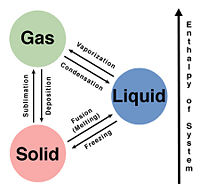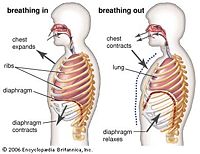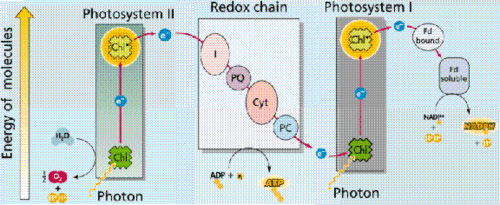Phase transitions in biological systems
Phase transitions are present everywhere. Even within something as complex as the human body or plants, phase transitions are still present throughout processes which these systems use to survive. Critical phenomena such as second-order phase transitions are hard to find in certain biological systems however first-order phase transitions are easily present. Trying to analyze a biological system to define that phase transitions that occur within the system can sometimes be difficult but they are there.
The Human Body as a Biological System
The human body is a very complex biological system with many organ systems within itself that allow bodily process to maintain life. Within these systems, various phase transitions do occur. Many of these phase transitions are necessary in order for things to work.
Respiratory System
Respiration itself requires many phase transitions. It begins simply with the inhalation of O2 gas which enters the lungs. Inhalation is done by stimulation of pulmonary muscles which allows the diaphragm to contract, allowing oxygen to enter the lungs. Oxygen gas gets absorbed into the bloodstream through little compartments that make up the lungs known as alveoli by way of diffusion. The oxygen gas binds to a solid protein known as hemoglobin, and is then carried throughout the body in blood, which in can be considered a liquid. In term of phase transitioning, the oxygen gas diffuses into liquid blood and remains there by way of binding to a solid protein.
Digestive System
Breakdown of food for energy. ATP.
Circulatory System
Transportation
Nervous System
Various signaling pathways
Reproductive System
The fertilization of an egg by sperm is irreversible.
Plants as a Biological System
Photosynthesis
Biological Thermodynamics
Biological Thermodynamics combines the laws of thermodynamics with biology in order to explain or possibly quantify changes in energy from reactions. Many organ systems within the human body, (if not all of them), require some energy in order to function. In a plant, photosynthesis converts sunlight to energy usable by the plant so that it may synthesize sugars out of carbon dioxide gas and water. There has to be some sort of method to quantify the energy required in these reactions.
Sources
1. “Digestion”, 15APR09, <http://en.wikipedia.org/wiki/Digestion>
2. Fox, Stuart Ira, “Human Physiology”, 10th Edition, McGraw-Hill Companies, 2008
3. “MIT Department of Physics: Biophysics: Biological and Medicine”, 15APR09,< http://web.mit.edu/physics/research/areasofresearch/atomic_cm_plasma/biophysics/biophysics.html>
4. “Nervous system”, 15APR09, <http://en.wikipedia.org/wiki/Nervous_system>
5. “Phase Changes”, 15APR09, < http://hyperphysics.phy-astr.gsu.edu/hbase/thermo/phase.html>
6. “Phase transition”, 15APR09, <http://en.wikipedia.org/wiki/Phase_transition>
7. “Photosynthesis”, 15APR09, <http://www.emc.maricopa.edu/faculty/farabee/BIOBK/BioBookPS.html>
8. “Photosynthesis”, 15APR09, <http://en.wikipedia.org/wiki/Photosynthesis>
9. “Soft Condensed Matter: where physics meets biology”, 15APR09,< http://physicsworld.com/cws/article/print/169>
10. “Types of Photosynthesis”, <http://wc.pima.edu/~bfiero/tucsonecology/plants/plants_photosynthesis.htm>
11. "Biological Thermodynamics", <http://en.wikipedia.org/wiki/Biological_thermodynamics>



